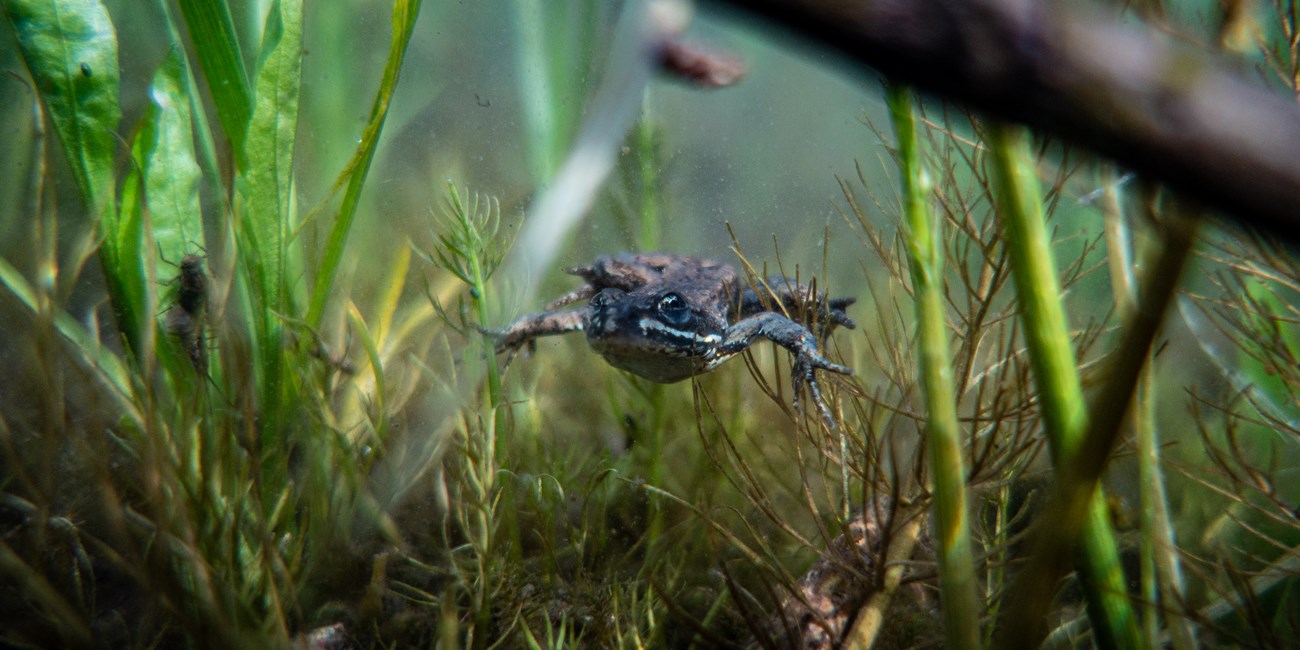
OverviewGlacier National Park contains over 1,500 miles of streams and rivers and about 700 lakes, ponds, marshes, bogs, and other wetland habitats. These habitats are vital for amphibian survival in the park, but with the comparatively recent withdrawal of Pleistocene ice sheets from the region, the diversity of the park’s amphibian fauna is relatively limited. Only six species of amphibians live in the park. The recent invasion of the chytrid fungus, Batrachochytrium dendrobatidis, has led to declines in the number of amphibians across the globe, including in Glacier National Park. Glacier National Park is home to 6 species of amphibians, including 4 frog species, 1 toad species, and 1 salamander species.
Western Toad (Anaxyrus boreas)Glacier is home to a subspecies of Western Toad known as the Boreal Toad (Anaxyrus boreas boreas). Identification: Adults have brown, gray, or olive green skin with irregular dark spots and a white stripe down the back. The average size is 2.4 - 4.7 inches. Females and males look very similar, but females can grow larger and males usually develop a dark pad on both thumbs during breeding seasons. Calls are made only by males and are a series of high-pitched chirps or peeps, which could be used to attract females or inform other males of their presence. Juveniles usually have a less distinctive white stripe down their back and yellow or orange toe pads on the undersides of their feet. Tadpoles are black or dark brown with pigmented tail fins. They can grow up to 1.5 inches in length usually swim in large groups until they metamorphose after 6-13 weeks. Range: Western toads are found from Alaska and British Columbia to Baja California throughout the Western US (down through Washington, Oregon, Utah, Idaho, California and Nevada). The range extends eastward to southwestern Alberta, western Montana, western and southern Wyoming, Colorado. Their elevation range is from sea level up to 3600 meters. Western toads are found across the park from the shores of Lake McDonald to Logan Pass to the beaver ponds along the South Shore Trail in Two Medicine. Adults breed in slow moving streams, ponds, marshes, lakes, and reservoirs. Reproduction: Females lay long strings of black eggs containing 3,000 to 10,000 eggs. Depending on water temperature, eggs hatch in 1-2 weeks and tadpoles metamorphose in 6-13 weeks. Toads migrate to the surrounding forest or meadows to hibernate during the winter in burrows. Juveniles mature in 2-4 years. 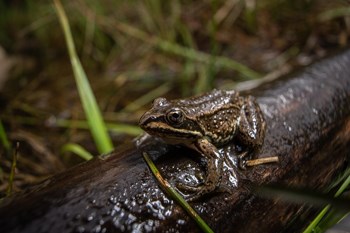
Columbia Spotted Frog (Rana luteiventris)Identification: Adults and juveniles have smooth dark green, tan, or reddish brown skin with irregular black spots and a cream colored “mustache” stripe that runs from the tip of the snout to the top of the front leg. They also have a cream-colored underside that turns salmon on the belly and thighs in adults. Females and males grow from 1.8 to 3.9 inches long and look very similar, but males usually develop a dark pad on their thumbs during breeding seasons. Calls are hollow series of clicks like knocking on wood. Range: Columbia spotted frogs range from northern British Columbia to central Nevada and east to Saskatchewan, Montana, and western Wyoming, northcentral Utah. They range in elevation from 500 meters to 3000 meters. They are found all over the park in ponds and occasionally in springs, shallow streams, or puddles. Reproduction: Females usually lay eggs communally in large clumps. Eggs hatch after 12-21 days and tadpoles metamorphose after 8-16 weeks. Juveniles mature in 2-5 years. Columbia spotted frogs overwinter and stay active in frozen ponds, then breed once the ice melts. 
Rocky Mountain Tailed Frog (Ascaphus montanus)Identification: Adults have rough-looking tan to reddish brown or greenish gray skin with green or gray mottling. There is a dark triangle or bar between the eyes. Males have a prominent cloacal “tail” which is used during mating that females do not have. Adults grow 1.2-2.2 inches in length. They have suctioning mouths that allow them to cling to rocks in fast moving streams. Tadpoles are dark brown and can grow to 2.5 inches in length. Range: Found in the Northern Rocky Mountains in Idaho and Montana as well as several small populations in southern Washington and Oregon above 975 meters. They live in cold and clear mountain streams where the water temperature rarely exceeds 55° fahrenheit (13° celsius). Reproduction: Rocky mountain tailed frogs are adapted for fast-moving, loud mountain streams. They are one of the only species with internal fertilization. Adults do not produce calls. Females likely lay eggs every other year. Tadpoles metamorphose after three years.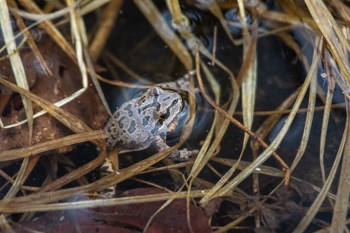
Pacific Tree Frog (Pseudacris regilla)Identification: Adults vary in their dorsal coloration from brown, green, gray, tan, bronze, red, or black. Some individuals have irregular markings or patterns on their backs. They grow from 0.7 to two inches in length. They are best identified by their rounded toe tips and an eye stripe that extends from the snout to the shoulder. Males have a dark throat that inflates while calling. Tadpoles are varying shades of dark brown to olive green with mottling or spotting and can be identified by their protruding eyes on the sides of their head. Range: They are found throughout the pacific northwest from British Columbia down to Baja California and from the Pacific Ocean to western Montana. Found west of the Continental Divide in Glacier National Park and breed in slow-moving freshwater bodies, but can be found in moist habitat under rocks or logs, in animal burrows, and in woodlands and grassland. Reproduction: These treefrogs call in loud choruses often during the day. Males call to defend territory and will fight other males via headbutting and kicking with their feet. Adults breed as soon as the snow melts and eggs hatch after two to three weeks. Larvae metamorphose after two to three months, and some individuals breed after one year but most reach sexual maturity after two years.
Boreal Chorus Frog (Pseudacris maculata)Identification: Adults are small with smooth gray, green, or dark brown skin with three dark green stripes or sets of spots down the back. They grow from 0.7 to 2.6 inches in length. Like Pacific tree frogs, they have a dark triangle or bar between the eyes, but lack rounded toe tips. Males call during the day and night, making a rising trill like a finger running down a comb. Range: They have a large distribution across North America east of the Continental Divide from Yukon Territory and Montana to Hudson Bay and Wisconsin, south to Arizona and New Mexico. In Glacier, they are found in some wetlands in the park east of the Continental Divide, particularly in the St. Mary area. Reproduction: Adults breed in early spring from May through June. Eggs hatch after 1-2 weeks, tadpoles metamorphose after 2 months, and reach sexual maturity after one year. These frogs may only live 2-3 years, though. They are freeze-tolerant and flood their cells with glucose in the winter as a natural antifreeze.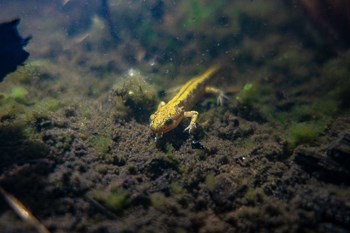
Long-toed Salamander (Ambystoma macrodactylum)Identification: Named for its long fourth toe on its hind feet, long-toed salamanders have a long uneven or blotchy stripe down their back that can be orange, yellow, or olive green. Body color can be gray with speckles of blue, white, or silver. Range: They are found from southern Alaska to northern California, from Pacific Ocean to western Montana. Both east and west of Continental Divide in GNP in most wetlands, but adults tend to spend more time in terrestrial forested habitats surrounding the wetlands. Reproduction: Adults breed in early spring once the ice melts in wetlands. Eggs hatch after 2-5 weeks, tadpoles metamorphose in one summer, but can wait 1-2 years in high elevation, cold ponds. Juveniles reach sexual maturity after one year and live 5-6 years. Typically spend days in burrows and emerge at night to eat.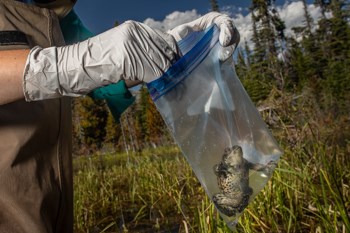
Threats to AmphibiansOne of the biggest threats to amphibians is the chytrid fungus. The chytrid fungus (Batrachochytrium dendrobatidis) is a disease agent responsible for chytridiomycosis in amphibians. The disease was first described in 1998 and is one of the main factors attributed to the decline of amphibians worldwide. However, not all amphibian species are equally impacted. Chytrid is widespread throughout Glacier and research is ongoing. Full Amphibian Species List:Select a Park:Select a Species Category (optional):
Search results will be displayed here.
|
Last updated: August 23, 2024
